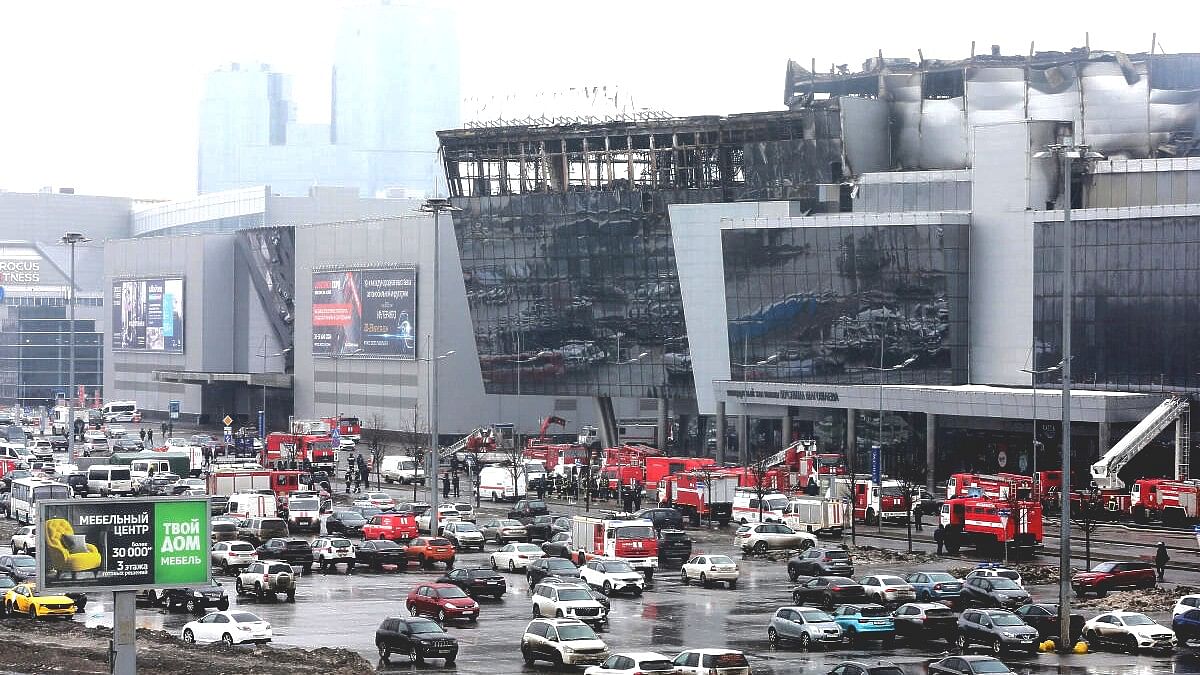
A view shows emergency services vehicles in front of the Crocus City Hall concert venue following Friday's deadly attack, outside Moscow, Russia, March 23, 2024.
Credit: Reuters Photo
At least 115 people were killed in an attack on Friday near Moscow, Russia's Investigative Committee said, citing preliminary data, and warned that the number of victims was expected to rise further.
The United States has intelligence confirming Islamic State's claim of responsibility for a deadly shooting attack at a concert near Moscow on Friday, a US official told Reuters.
Let's take a look at Islamic State's Afghan branch known as ISIS-K, which has claimed responsibility for the terror attack.
What is Khorasan?
Khorasan is a historical term for areas populated by peoples speaking Iranian languages in northeastern Iran, the Transoxania part of Central Asia (Mawr-un-Nahr) and Afghanistan, mainly north of the Hindu Kush Mountains. In IS propaganda, it now comprises all of Afghanistan, most of Pakistan as well as Central Asia. Its reaches are felt as north as Kazakhstan and in eastern Turkistan, suggests Borhan Osman in an Afghanistan Analysts Network article.
The beginning
In late January 2015, the Islamic State expanded into Khorasan province, with its main contingent emerging from Nangarhar province, Afghanistan. These fighters were originally Pakistani militants settled in Nangarhar's southeastern districts since around 2010, mainly fleeing Pakistani military operations. They were initially associated with various groups under the Tehrik-e Taleban Pakistan (TTP) before affiliating with ISKP.
Arriving in Achin, Nazian, Kot, Deh Bala, Rodat, and Ghanikhel districts, they portrayed themselves as refugees seeking shelter and garnered support from local Pashtun communities. Over time, they transformed into armed militants aligned with Pakistani groups. The Afghan government attempted to co-opt some of them to use against Pakistan, while tribal elders sought their allegiance for personal or factional gain. Notably, the group led by Mangal Bagh found refuge in Nangarhar, with an estimated membership of at least 500 at the time, Osman's research suggest.
Prior to openly shifting their allegiance to Islamic State, they displayed indications of restructuring under a new operational approach. Beginning in the autumn of 2014, they began to operate with greater independence from the TTP, seemingly attempting to exert control over their residing areas by establishing impromptu checkpoints. Additionally, they seemed to be gearing up for a significant confrontation, regularly transporting large quantities of weapons from the Tirah valley in the Khyber Agency, a departure from previous patterns in both volume and frequency.
ISIS-K post 2014
In early July 2015, two significant events set the stage for a full-scale conflict between ISKP and the Afghan government. Firstly, the United States commenced a series of lethal airstrikes from July 6, targeting ISKP positions. Secondly, there were coordinated efforts, potentially involving uprisings, by local residents alongside Taliban offensives against ISKP. These actions signaled a turning point in the confrontation.
It wasn't until mid-January 2016 that the United States officially labeled ISKP as a global terrorist organisation.
As one of the most active regional branches of the Islamic State militant group, ISIS-K has experienced a decline in membership since reaching its peak around 2018.
The United States has acknowledged a reduction in its capacity to gather intelligence against extremist organisations in Afghanistan, including ISIS-K, following the withdrawal of US troops from the country in 2021.
What attacks has the group carried out?
ISIS-K has been responsible for nearly 100 attacks against civilians in Afghanistan and Pakistan, as well as roughly 250 clashes with the US, Afghan, and Pakistani security forces since January 2017, suggests analysis of ISIS-K, published by CSIS.
The group claimed responsibility for the suicide attack on the TUTAP protests in Kabul on 23 July 2016. The attack killed more than 80 people and injured over 230 others in Deh Mazang Square in western Kabul.
Earlier this year, the US intercepted communications confirming the group's responsibility for dual bombings in Iran, resulting in the deaths of nearly 100 individuals.
In September 2022, ISIS-K militants claimed accountability for a fatal suicide bombing at the Russian embassy in Kabul.
The group gained notoriety for an assault on Kabul's international airport in 2021, claiming the lives of 13 US troops and numerous civilians during the tumultuous US evacuation from the nation.
Recently, the senior US military official in the Middle East warned that ISIS-K could potentially launch attacks on the US and Western interests outside of Afghanistan "within as little as six months and with little to no warning."
Two people suspected of carrying out a deadly attack near Moscow have been detained after a car chase but others are still at large.